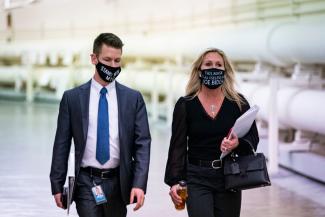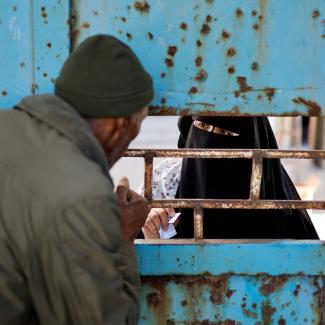Alfred Crosby described the great influenza pandemic of 1918–19 as “America’s forgotten pandemic.” Crosby was perplexed that such a terrible event had little, if any, lasting impact on the life of the nation. With the U.S. national emergency on COVID-19 ending in May, it is pertinent to ask how this once-in-a-century, devastating pandemic will be remembered.
The turmoil caused by COVID-19’s emergence and global spread triggered a tsunami of analyses on what went wrong and how the United States and other countries should transform policies on pandemic prevention, preparedness, and response. This series on U.S. foreign policy and global health participates in this effort at diagnosis and prescription. Synthesizing such commentary proves difficult, if not foolhardy, and the question of how the COVID-19 pandemic will be described in the future cannot be definitively answered today. Some themes, however, suggest that COVID-19 will be remembered as the polarized pandemic that cast a divisive shadow on U.S. public health, domestic politics, and foreign policy.
COVID-19 will be remembered as the polarized pandemic that cast a divisive shadow on U.S. public health, domestic politics, and foreign policy.
Polarization of Public Health
The pandemic has generated a renewed focus on the long-standing policy imperatives that public health challenges create. To address those challenges, policy should be informed by science and epidemiology and implemented through collective action. These imperatives form the core of effective public health actions. That is why analyses of previous disease events and COVID-19 have stressed the need for — among other things — better surveillance, improved diagnostic tests, broader data sharing, faster vaccine development, trusted communications, adequate emergency stockpiles, and deeper cooperation within and among countries. Pandemic prevention, preparedness, and response will fail without these capabilities.
Yet just about every country — including the United States and other high-income nations — was unprepared for a pandemic, struggled to respond to COVID-19, and suffered terrible consequences. Across 2020 through 2022, data indicate that the United States “has consistently had among the highest COVID-19 mortality rates in the world.” That lack of preparedness and poor track record highlight — once again — the dangers of the long-recognized “crisis and complacency” or “panic and neglect” cycle in U.S. domestic and foreign policies on public health. But COVID-19 cuts deeper concerning this pattern.
After the Cold War, the United States and other high-income democracies became global health leaders by focusing and spending more on global health than ever before. In this period, experts identified a pandemic involving a respiratory virus, such as a novel influenza or coronavirus strain, as posing the most dangerous threat. However, the global health leadership of democratic nations consistently prioritized other issues over pandemic preparedness.
The Institute of Health Metrics and Evaluation calculated that, between 1990 and 2021, development assistance for health (DAH) — largely provided by high-income democracies — totaled only $6.5 billion on pandemic preparedness, “less than one cent out of every dollar spent on DAH during this period.” In contrast, the United States alone has spent more than $100 billion on HIV/AIDS in sub-Saharan Africa since establishing the President’s Emergency Plan for AIDS Relief (PEPFAR) in 2003.
COVID-19 casts a harsh public health light on the marginalization of pandemic preparedness during decades in which democracies claimed global health leadership. This leadership systematically failed to heed the policy imperatives associated with the most dangerous threat to public health in a century. That failure prompts uncomfortable questions. How should post-COVID policymaking remedy the disequilibrium in public health unmitigated for thirty years?
COVID-19 makes public health policymaking more zero sum and, as a consequence, polarizes it. Concerns that decisions made to strengthen U.S. pandemic preparedness could damage PEPFAR illustrate this new context. COVID-19 has generated massive demands for improving pandemic preparedness and repairing the damage that the pandemic did to every area of global health for which there is not enough political and economic capital. The scale of the changes and resources needed creates little room for win-win reforms across public health problems. Even worse, decades of policy failures confront rich and poor nations with the added burden of adapting to health threats associated with climate change — an area of global health that has received even less attention than pandemic preparedness.
Pandemics are more products of their times than they are producers of the future.
Polarization of Domestic and International Politics on Public Health
Unfortunately, policy triage in public health will take place amid domestic and international politics increasingly hostile to collective action based on science and epidemiology. Before COVID-19 emerged, domestic politics in the United States and other countries had become more populist, nationalistic, and partisan. The return of geopolitical competition for power and ideological advantage had started to affect international relations. The pandemic exacerbated both trends and helped produce the worst political conditions at home and abroad for public health policymaking in the post–World War II era.
In the United States, public health — and the science and epidemiology that informs it — is under attack at the federal and state levels because of COVID-19. Lena Wen warned that, because public health is now synonymous with COVID-19 and COVID-19 is polarized, “public health becomes polarized, too.” The divisiveness and disruption are creating worries that the United States will be even less prepared for the next pandemic than it was for COVID-19. Foreign aid, including DAH, is in the crosshairs because of nationalism, populism, and escalating battles over the federal deficit and the debt limit. The emerging divide-and-disrupt political dynamic is more dangerous than the crisis-and-complacency pattern.
In foreign policy, geopolitics warped pandemic responses and marginalized global health, sending the message that realpolitik calculations — not the public health imperatives of science, epidemiology, and collective action — reign supreme. The prominence of geopolitics during the pandemic also illuminated that China and Russia changed the balance of power and helped push democracy into global decline without seeking global health leadership. The billions spent on global health through PEPFAR and other initiatives produced no geopolitical benefits for the United States against Chinese and Russian efforts to gain power, wield influence, and undermine democracy. The severity and stakes of geopolitical competition has adversely affected the prospects for multilateralism across policy areas, including pandemic preparedness and climate change.
The geopolitical context has demonstrated that global health leadership neither prepared the United States for a pandemic nor provided advantages in defending U.S. vital interests against rising and revanchist authoritarian rivals. In addition, this context produces a conundrum for the United States. Even though global health leadership generated no geopolitical traction, reducing global health involvement in strategic regions would become anti-American fodder in the competition for power and influence, especially in Africa. Put differently, PEPFAR has become a geopolitical trap for the United States.
Pandemics, What Are They Good For?
Crosby’s description of the great influenza disaster as the forgotten pandemic and my musings that COVID-19 will be remembered as the polarized pandemic suggest that pandemics are more products of their times than they are producers of the future. As others have observed, the COVID-19 pandemic reinforced and accelerated, rather than disrupted and diverted, domestic and international political developments under way before the Wuhan outbreak.
This conclusion challenges the adage that pathogens do not recognize borders — a trope designed to elevate the imperatives of public health in policymaking. In light of the great influenza and COVID-19 pandemics, perhaps a different mantra is needed — that politics often prove impervious to pathogens.



